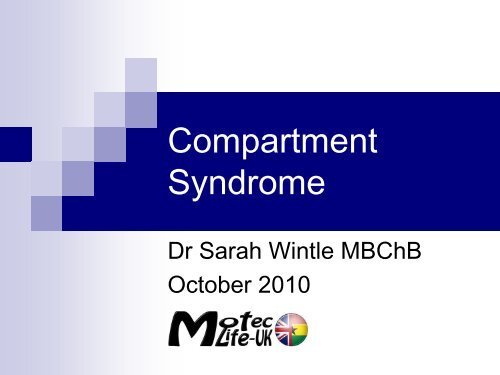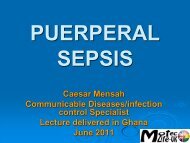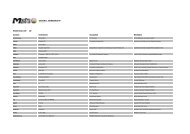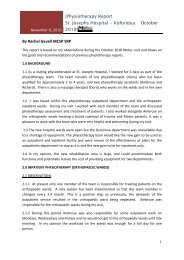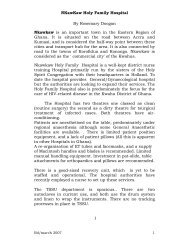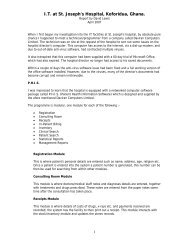Compartment Syndrome.pdf - MOTEC LIFE-UK
Compartment Syndrome.pdf - MOTEC LIFE-UK
Compartment Syndrome.pdf - MOTEC LIFE-UK
You also want an ePaper? Increase the reach of your titles
YUMPU automatically turns print PDFs into web optimized ePapers that Google loves.
<strong>Compartment</strong><strong>Syndrome</strong>Dr Sarah Wintle MBChBOctober 2010
Aims and Objectives• What is compartment syndrome?• Understand the anatomy involved• Causes• History and examination• Investigations• Treatments• Complications
What is <strong>Compartment</strong> <strong>Syndrome</strong>?• Compression of nerves, blood vessels andmuscle within a closed space• Can lead to tissue death throughischaemia• Commonly involve forearm and lower leg• Divide into acute, subacute or chronic• Life/limb threatening emergency
Some anatomy…• Fascia divides muscle groups intocompartments• Forearm contains 4 compartments:- superficial volar- deep volar- dorsal- mobile wad
Some more anatomy…
Some more anatomy…• Lower leg contains 4 compartments:- Anterior (tibialis anterior, extensor hallucis longus, extensordigitorum)- Lateral (peroneus longus, peroneus brevis)- Deep posterior (tibialis posterior, flexor digitorumlongus, flexor hallucis longus)- Posterior (gastrocnemius, soleus)
Some more anatomy…
Causes of <strong>Compartment</strong> <strong>Syndrome</strong>• Fractures• Haemorrhage• Crush injuries• Casts• Limb compression• Burns
History and Examination• Remember 5 P’s!-Pain- Paraesthesia- Pallor- Paralysis- Pulselessness
Passive dorsiflexion of the foot
History and Examination• Remember 5 P’s!-Pain- Paraesthesia- Pallor- Paralysis- Pulselessness
Investigations• Often diagnosed on history alone• Measurement of intracompartmental pressures-normal resting pressures 0 - 10 mmHg-if >30 mmHg, treat as CS• Measure BP: if diastolic BP - intracompartmentalpressure > 30 EMERGENCY!
Intracompartmental PressureMeasurement
Investigations• Often diagnosed on history alone• Measurement of intracompartmental pressures-normal resting pressures 0 - 10 mmHg-if >30 mmHg, treat as CS• Measure BP: if diastolic BP - intracompartmentalpressure > 30 EMERGENCY!
Treatments• Conservative: elevate, remove all bandages,split cast (if not already split)• Operative: fasciotomy
Complications• Necrosis of tissue- amputation- contractures, eg Volkmann’s- rhabdomyolysis
Volkmann’s Contracture
Complications• Necrosis of tissue- amputation- contractures, eg Volkmann’s- rhabdomyolysis
Aims and Objectives• What is compartment syndrome?• Understand the anatomy relating to CS• Causes of CS• History and examination• Investigations• Treatments• Complications
Thank you!Any questions?


